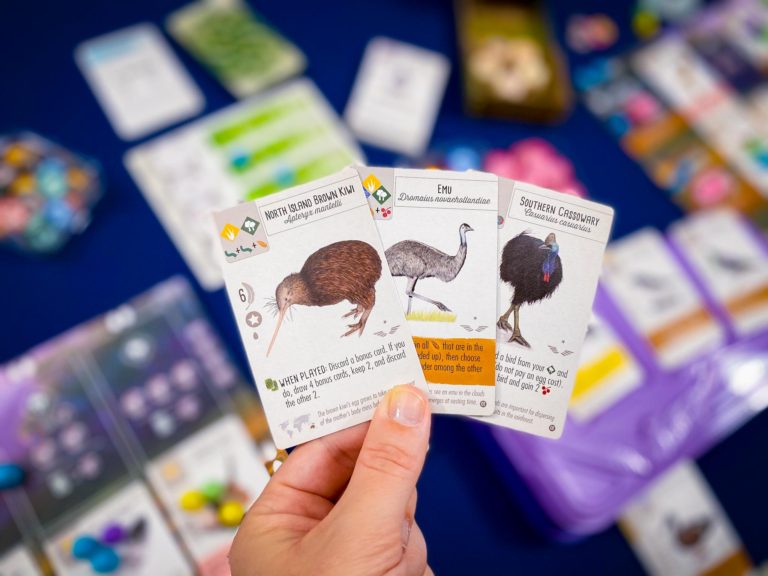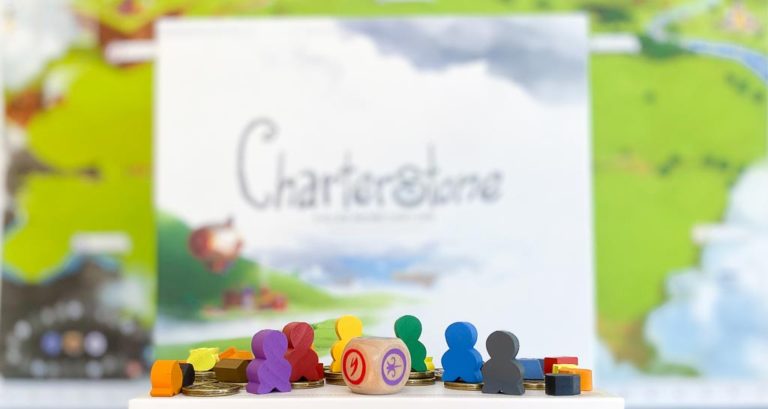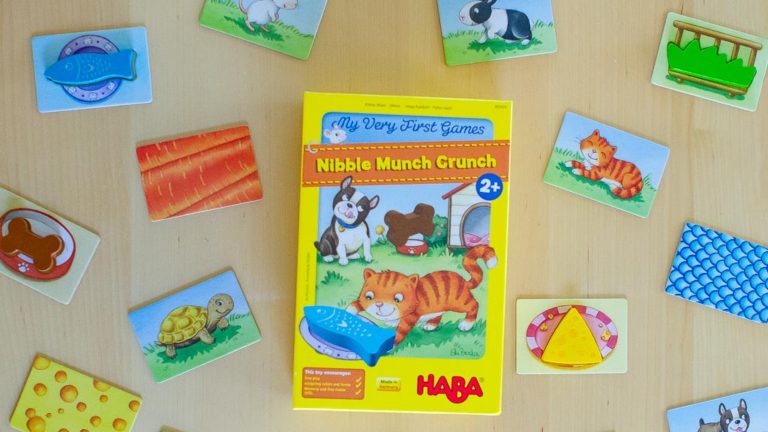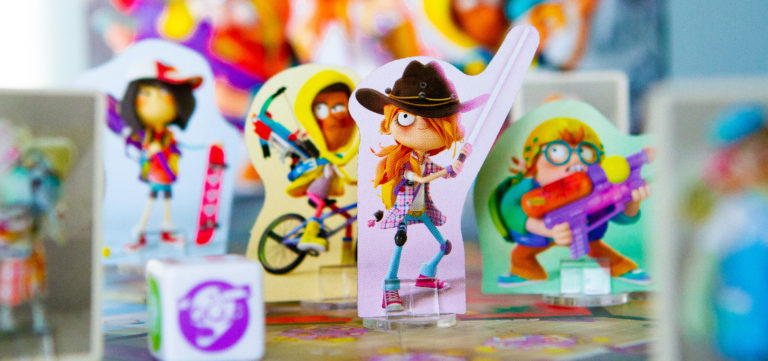If you love a game with a little more meat on its bones, that will challenge you mentally, and that won’t eat up your whole evening, you’re definitely going to want to check out this game!
What is Euphoria?
Euphoria: Build a Better Dystopia, is a worker placement game where players are trying to take control of the city of Euphoria in this dystopian universe. With a handful of oblivious workers (dice) and recruits (cards) you will work to take control of the city before your opponents.
You win the game by being the first to place all ten of your authority tokens (stars) on the board.
How do you play?
Euphoria is a surprisingly straight forward game to play, even if there is a bit of a learning curve. That being said, there are a lot of rules, far more than would probably be enjoyable to read in a blog post. I’ll give you a quick breakdown of them before giving you our thoughts on the game below, but certainly, you’ll want to read the rules carefully before your first play.
Let’s briefly look at the cards you’ll be using in the game.
Recruits
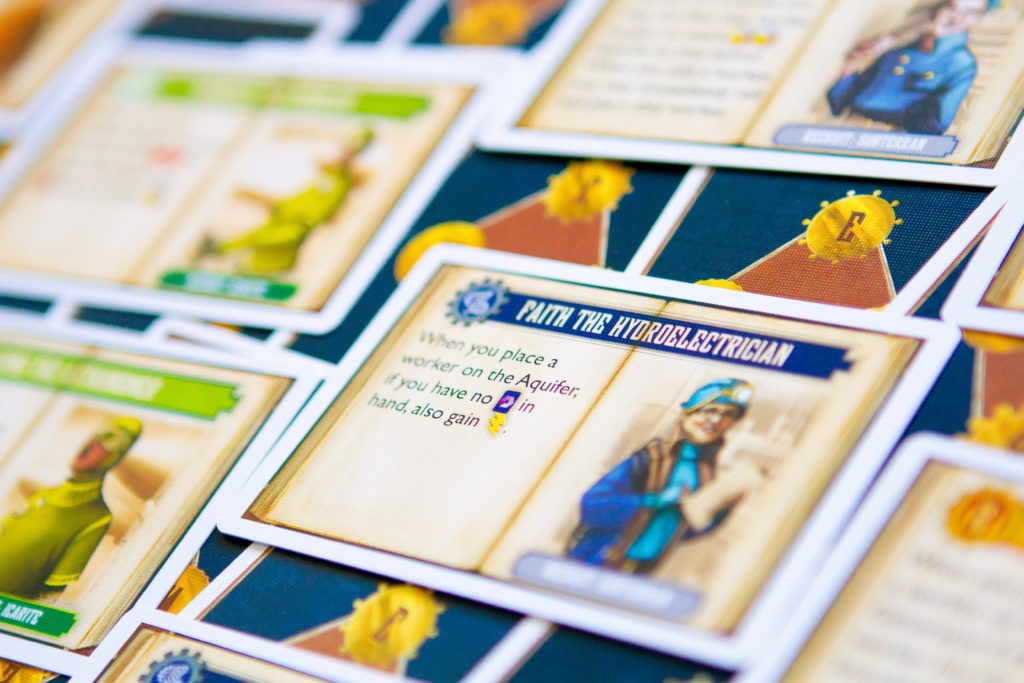
Recruits are extremely loyal followers with power and influence of their own, ready to do your bidding as you seek dystopian glory. These recruits each belong to various factions on the board and give you a special ability when they are active. To start the game, each player has two recruits, one face up and one face down. Recruits are considered to be “active” when they are face up. Your face down recruits will not be able to be used until they become active and are flipped over.
Artifacts

These cards represent rare objects of the old world are used during the game to pay for plots of land in the dystopia.
Now lets discuss the important charts on the board you’ll be using throughout the game.
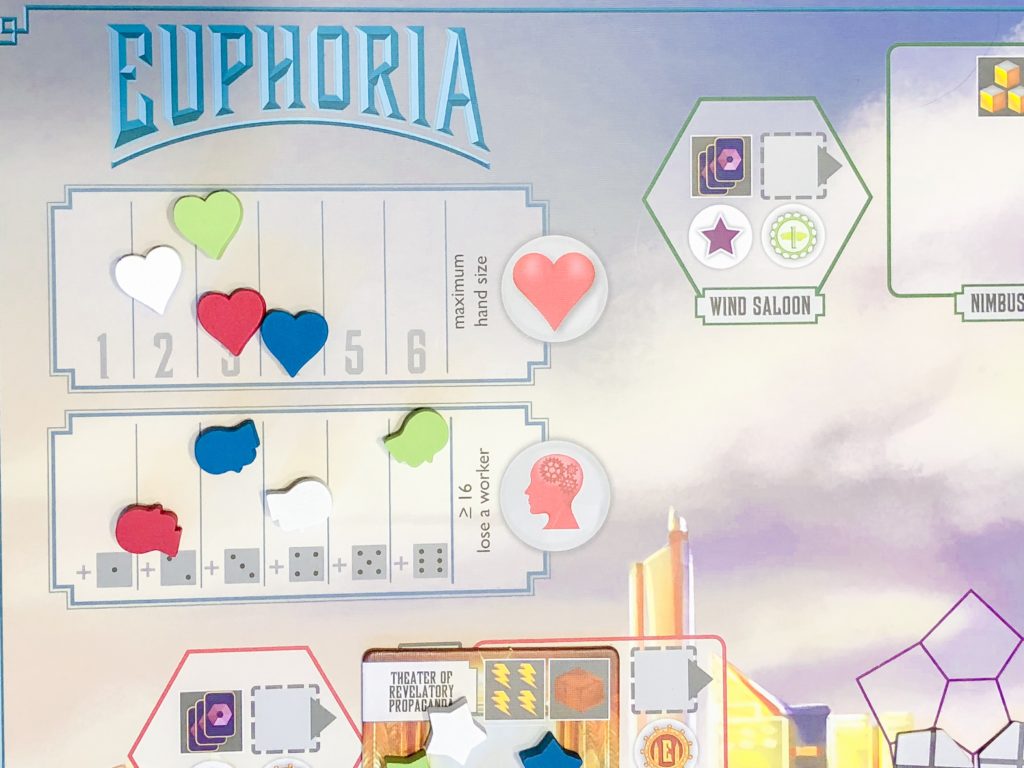
Morale Chart
Every dystopian leader needs workers to do their bidding. But sad workers aren’t as helpful as happy workers. The higher the morale of those under your charge, the better you are able to work.
The morale chart affects your hand size. When you gain morale, you increase the number of artifact cards that you can have in your hand. When your morale decreases, your hand size does as well.
If ever you would draw an artifact card that would increase your hand size beyond your limit, or if an adjustment of morale during play puts you over your maximum hand size, you must discard a card to adjust to your new limit.
Knowledge Chart:
Much like happy workers are more helpful to the dystopian ruler, intelligent workers are pretty much the worst. It’s best to keep those under your thumb a bit in the dark if you hope to get anything done.
The knowledge chart tracks the, you guessed it, knowledge of your workers. This represents their level of awareness of their world. If their collective knowledge ever gets too high (16 or higher) then they’ll leave the dystopia.
When you retrieve or receive workers you’ll immediately roll them to check their collective knowledge. To do this, add up the pips on all of your available workers (not any that are placed on the board, just those available to you to place) and add that number with your current position on the knowledge track. If that number equals 16 or greater, then you lose the worker with the highest knowledge immediately. You are no longer allowed to play with that die and it is returned to your pool of recruitable workers.
Allegiance Track
This tracks the strength of each faction. Unlike the Morale and Knowledge trackers which track individual players, the allegiance track is used by everyone.
When any player gains an allegiance point from a space on the board, that player moves the associated faction forward one space on the allegiance track. If you have an active recruit of that allegiance, you’ll gain the bonuses from that track when placing workers even if you weren’t responsible for moving the tracker.
The bonuses are cumulative and unlocked in tiers. Once one tier is unlocked, that benefit will still be gained after the second tier is unlocked.
Now, lets talk a bit about turn actions!
Actions
On your turn, you will perform one of two actions.
- Place an available worker in your control on the board, immediately gaining the benefits of that action. Or
- Retrieve any or all workers, paying the cost, and immediately rolling all retrieved workers at the same time.
Worker Placement
On the board there’s pretty much a buffet of options to place your workers. The best part is the game has some stellar iconography to help you understand and identify what type each space is, it’s cost (if any) to use, and the benefits of placing your worker there.
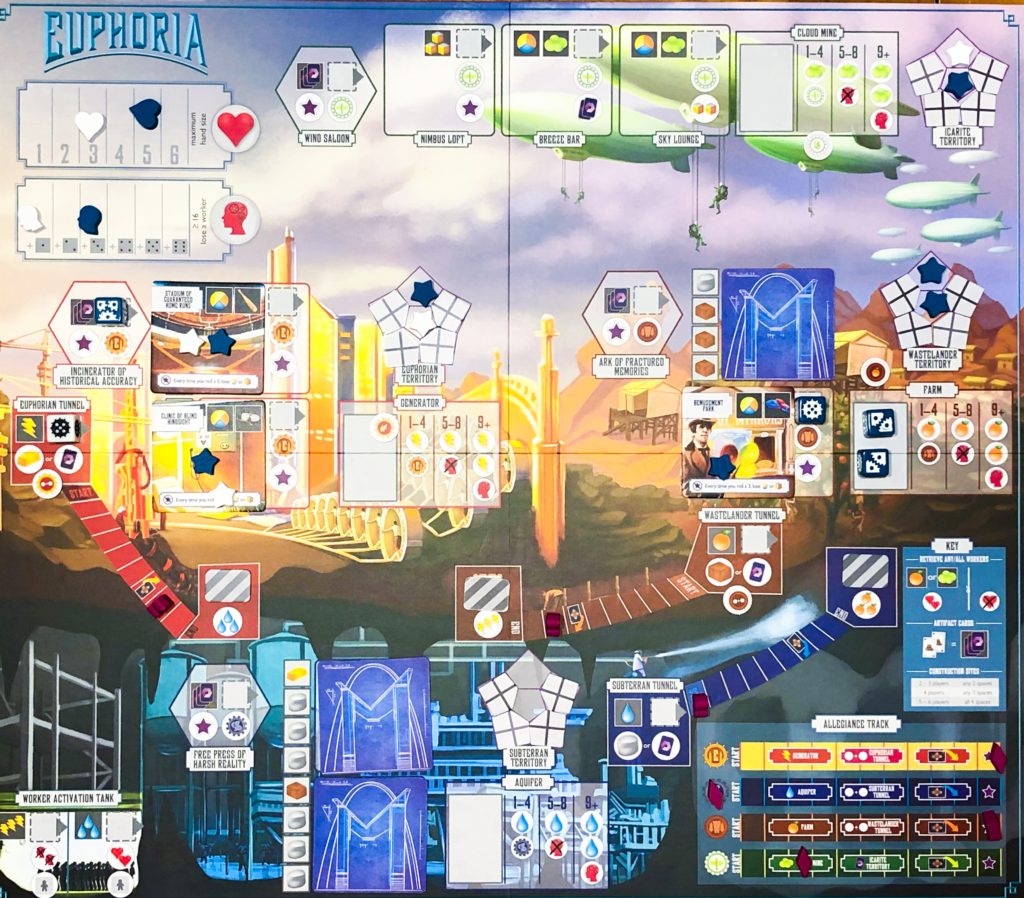
Temporary Use:
These spaces are marked with a light grey square with a dashed line around it and an arrow to the right. You may place your worker on this type of space even if there is already a worker there. If you place your worker on an occupied temporary use action space, you’ll merely bump the worker back to its owner (even if its you) with no cost to either player.
Some temporary use spaces have a cost associated with them. This cost is always directly to the left of the action space in a dark grey square, where as the benefits will be below the action in a white circle.
Multi-Use:
This action space is represented by one large light grey rectangle. Any number of workers may be placed here. Their collective knowledge will be added together which will tell you what the benefit will be based on the number.
One-Time Use:
These action spaces are solid light grey squares with no arrow and a resource cost inside of it. To place a worker here, you must pay the cost. You cannot be bumped from these spaces.
Locations
As mentioned, there are a lot of places where you can place workers in Euphoria. Here’s a quick break down:
Worker Activation Tank
You start the game with two workers. If you’d like to get more, you’ll have to go here. You can have a total of 4 workers during the game.
Commodity Areas
This is where you’ll collect the various commodities you’ll need to use during the game. When you place a worker in a commodity area, a multi-use space, you’ll add up the knowledge of all the workers currently using the space to determine the number of commodities you collect.
Tunnels
Each faction is trying to tunnel into another area of the world to gain access to their enemy’s commodities.
While tunnels are located in specific factions, they are able to be used by any player. Every time the tunnel is used, the miner moves a bit farther down (one space) until eventually reaching the end of the tunnel, unlocking an exclusive action. This exclusive action may ONLY be used by players who have a currently active recruit of that faction.
Construction Sites
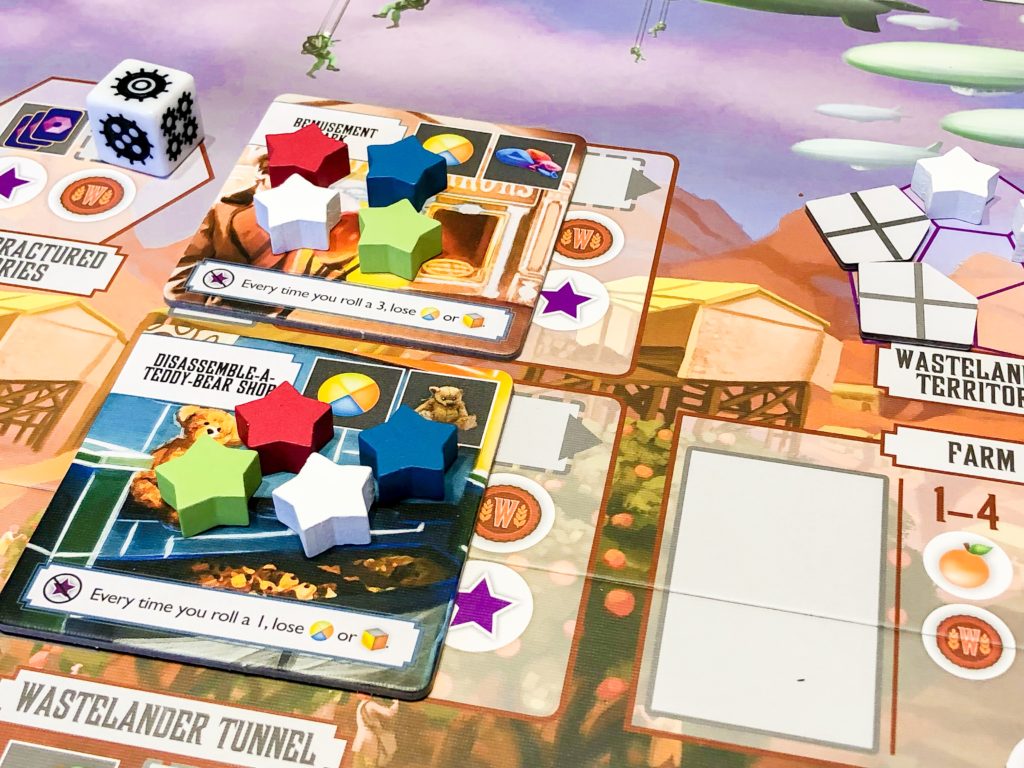
Here players can place workers on one-time use spaces to contribute to the construction of an unknown market. Workers played here may not be bumped or retrieved until the market is built. The number of players determines how many workers are needed to build the market.
When the required number of workers needed to build the site is met, the market is complete and will be flipped over, revealing the market itself and the temporary action space it was covering. It will also bump all of the dice back to their owners in the process. Everyone who contributed to the building of the market will get to place an authority token (star) on the market tile, those who did not will incur the penalty indicated on the tile.
Once built you can exchange goods for land in that faction’s territory. Simply visit the market, pay the cost, then place an authority token in that factions star-shaped territory.
Artifact Markets
Each faction comes with a pre-built Artifact Market. These work similar to construction sites. Players will need to pay either three unique artifact cards or two matching artifacts. Players who do this will then be able to place an authority token on the star-shaped territory space or on a constructed market in that same faction they do not currently have a star on.
Ethical Dilemmas

Finally, once per game players can choose to resolve their Ethical Dilemma card. This is a card given to each player at the start of the game. When resolving, they will pay the cost and then choose whether to draw two recruits and keep one, or place an authority token on the card.
Game End
Players will take turns until one player has placed all ten of their authority tokens on the board. Ties are resolved if they occur.
What’s in the Box?
Euphoria’s artwork is absolutely fantastic. The board is so beautiful with bright colors and intriguing scenes. Everyone always takes some time to examine it during play.
The wooden pieces and dice are also great. The six colors for players to choose from area all easily distinguishable from each other on the board and easy to make out even amongst the vibrant board art.
The cards are beautifully illustrated and of nice quality. I especially like just how many recruit cards are included. This helps with the games replayability. We’ve played numerous times now and still have lots of recruit cards we’ve yet to see.
The best component in the box however are the Game Trayz inserts which are included in the current printing of Euphoria. There are so many parts and components to Euphoria that I know if we didn’t have the Game Trayz and rather had to bag everything up after each play we would not get the game to the table as often as we have. Setup and tear-down is a breeze with these inserts. And because you can keep the resources and commodities in the tray to be used during the game, even playing is more manageable and organized. Just like with Wingspan and My Little Scythe, Stonemaier Games continues to spoil us with these inserts and I’m here for it!
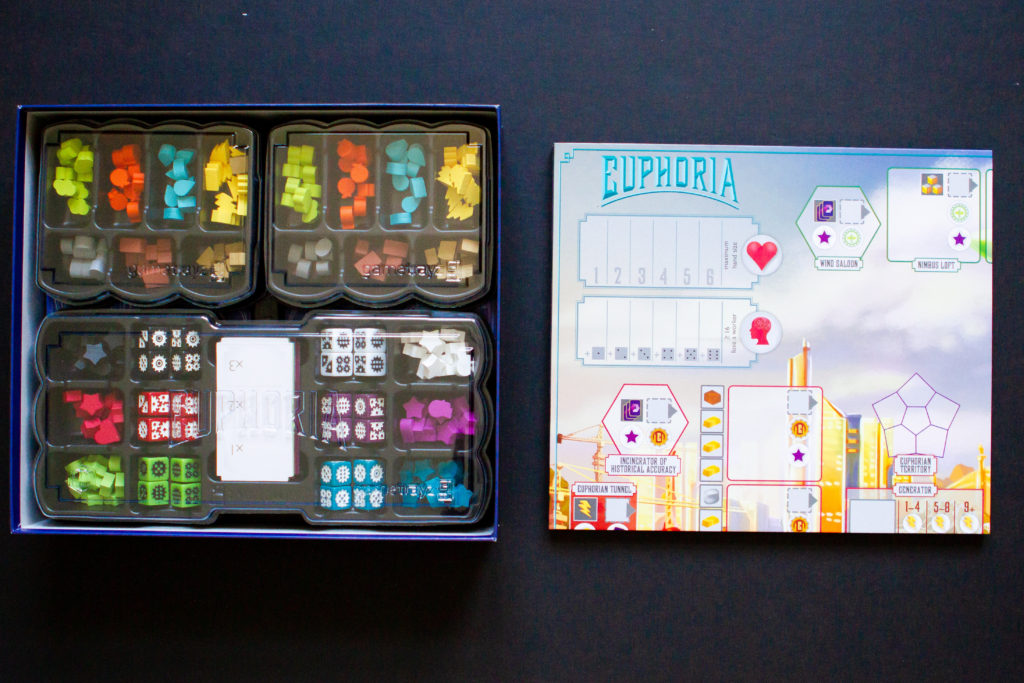
Our Thoughts:
We had a lot of fun playing Euphoria. The gameplay is really interesting with lots of options to keep each game feeling fresh and challenging, but not so many options that it feels overwhelming. That being said, Euphoria is anything but a “gateway” game. With elements of area control, resource and hand management, and worker placement all mixed together with unique player abilities and powers, there’s a lot that’s happening. If you’re an experienced game player with an understanding of each of these mechanisms, you’ll probably really enjoy Euphoria, but if you’re new to the majority of these, you might feel like you have a bigger hill to climb learning it.
Time needed to play
I really like that with Euphoria I can play a heavier game without sacrificing hours of my time. It plays surprisingly quickly, especially at two players. Each game we’ve played has clocked in around 45-70 minutes depending on how many are playing. Just know that if you are going to be teaching Euphoria to new players, it does take a bit of time due to everything that you’ll have to cover. It’s taken us about 20 minutes to explain the game enough to have new players feeling comfortable playing it, and then a bit of extra time at the beginning as everyone works through their first few moves or so with some questions here and there.
I was worried that each turn would take a lot of time due to the amount of options on the board but each turn is quick, not taking more than a minute if that, and because it’s just each player taking their turn one after the other until someone wins there’s very little to no down time between turns and no rounds to pause between and tally up scores. In fact, there’s not score keeping what-so-ever, (Can I get an AMEN!) You win by being the first to place all of your stars, not by points.
Play Experience:
The worker placement mechanic is utilized really well here. So often there is limited player interaction, and frequently its felt by players placing their workers somewhere someone else wanted/needed to go and boxing them out. In Euphoria, there is a lot of player interaction that comes from players placing their worker on an occupied temporary use action space and bumping the other player off.
I love that for the most part I’m not kept from using a space on the board just because someone else is there. In fact, this mechanic is incredibly fun and can be utilized in a a variety of ways. I love how sometimes I’m bumped off a space which returns my worker to me; now I don’t have to spend a turn calling workers back. Likewise you can even utilize the ability to bump a player off of a space to set them back a worker if returning one would force their knowledge to get too high, thus losing one of their dice.
This worked really well in our four player game. We were constantly interacting with each other’s workers in this way which was a lot of fun. And on the flip side, there were plenty of times where we could not bump someone off one of the market build spaces. This gave us the perfect amount of frustration and fun as we could use them both to further our game, and strategically keep others from doing the same.
The tunnels also offer a fun way for players to impact each others’ games. Once a tunnel is dug far enough, players might be able to reveal their hidden Recruit card if it belongs to that faction. It doesn’t matter if you ever contributed to the tunnel being dug, if your Recruit is part of that faction, you get to flip it over, benefiting your game going forward.
Does it Play Well with Two Players
While a lot of the fun in Euphoria comes from players being able to interact with each other, I still found the game enjoyable at two. It just has a different feel to it. With a higher player count, there’s a lot more interaction and a much higher potential for tunnels to be dug, hidden recruits to flip over, and dice to be bumped off temporary use spaces. In our two player games, while there is still the interaction it’s just a bit less and is largely dependent on which faction the Recruits you chose at the beginning belong to. In our games where we had faction overlap, there was a lot of interaction, in our games where we didn’t, less so.
That being said, Euphoria is probably best experienced with 4-5 players. The one draw back of higher player counts is that it became difficult to keep track of everyone’s special abilities. The more players we added, the harder it became, for me at least, to keep track of what each Recruit allowed each person to do, especially as hidden Recruits were revealed and Market tiles were flipped over, impacting some players further. If you like to keep an eagle’s eye on everything, this might be an issue for you in this game, at least at higher player counts. It was not an issue at two.
Theme
The theme really worked for me as well. For a euro-style game, Euphoria does a great job of incorporating a theme and telling a story through the artwork and mechanics. Typically I’m left a bit bored by euros due to the lack of theme, but there’s enough here to keep it fun and interesting, even incorporating a bit of humor. It’s pretty fun gathering your workers for a knowledge check and saying, “don’t be smart, don’t be smart…” as you prepare to roll them. I love a good dystopian novel and found the artwork choices really great. The popped balloons, teddy bear, books, even the Viticulture box (a fun call to another Stonemaier game and a favorite of ours) all are great choices for artifacts to represent a forgotten world and a better time.
Could kids play it?
I’ve gotta say “no” on this one. There is simply so much going on that it would probably be pretty rare for anyone under 13, as the box suggests, to grasp Euphoria enough to enjoy playing it. This is definitely a game that will be utilized best by more experienced players. For our multi-player game we had one observer who, at one point said, “I thought I could figure it out by watching you guys play, but I have no idea what is going on.”
Building a better dystopia isn’t exactly easy, even for some adults.
Summary
Euphoria is a great choice for those looking for a smart, mentally stimulating game with diverse mechanics that won’t eat up their whole day. The game is very well produced with beautiful components, art, and even inserts to help keep things organized and make set up and tear down fast and easy. The theme is incorporated very well and will delight those who find euros typically lacking in this area.
While the game plays best with 4-5 players, we still found it to be enjoyable at two for those who primarily game at this player count. If you like to play with higher counts, be warned that while it isn’t an overly complicated game to play, it is a bit more difficult to teach to new players. If you can make it past that step, Euphoria really shines as it offers a high level of player interaction as you are constantly impacting each others game with nearly each move you make throughout.
Replayability remains high with this game as there are so many Recruit cards included, each requiring different strategies that keep the game feeling fresh. Euphoria has so much going on with so many different strategies, Recruits, and Markets to try that it makes it a bit addicting.
Overall, Euphoria was another win for us from Stonemaier and a game I recommend.
If you’re interested in purchasing Euphoria, or if you’re already an experienced dystopia builder, know that Stonemaier Games has released an expansion for this game titled: Ignorance is Bliss. You can find out more information about the expansion by heading over to the Stonemaier Games website.
A special thanks to Stonemaier Games for providing us a copy of Euphoria: Build a Better Dystopia to review. As always, our opinions are our own.
Game Info:
Title: Euphoria: Build a Better Dystopia
Designers: Jamey Stegmaier, Alan Stone
Artist: Jacqui Davis
Publisher: Stonemaier Games
Ages: 13+
Price: $70
Published: 2013
If you enjoyed this review, you may also like:
Wingspan
10 Great Date Night Games
* This post contains affiliate links at no cost to you. To read my full disclosure policy click here.*


